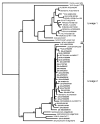Phylogenetic relationships of southern African West Nile virus isolates
- PMID: 12141968
- PMCID: PMC2732512
- DOI: 10.3201/eid0808.020027
Phylogenetic relationships of southern African West Nile virus isolates
Abstract
Phylogenetic relationships were examined for 29 southern African West Nile virus (formal name West Nile virus [WNV]) isolates from various sources in four countries from 1958 to 2001. In addition, sequence data were retrieved from GenBank for another 23 WNV isolates and Kunjin and Japanese encephalitis viruses. All isolates belonged to two lineages. Lineage 1 isolates were from central and North Africa, Europe, Israel, and North America; lineage 2 isolates were from central and southern Africa and Madagascar. No strict correlation existed between grouping and source of virus isolate, pathogenicity, geographic distribution, or year of isolation. Some southern African isolates have been associated with encephalitis in a human, a horse, and a dog and with fatal hepatitis in a human and death of an ostrich chick.
Figures

Similar articles
-
Integrated analysis of human-animal-vector surveillance: West Nile virus infections in Austria, 2015-2016.Emerg Microbes Infect. 2018 Mar 14;7(1):25. doi: 10.1038/s41426-018-0021-5. Emerg Microbes Infect. 2018. PMID: 29535293 Free PMC article.
-
Putative new lineage of west nile virus, Spain.Emerg Infect Dis. 2010 Mar;16(3):549-52. doi: 10.3201/eid1603.091033. Emerg Infect Dis. 2010. PMID: 20202444 Free PMC article.
-
Molecular characterization and phylogenetic analysis of Murray Valley encephalitis virus and West Nile virus (Kunjin subtype) from an arbovirus disease outbreak in horses in Victoria, Australia, in 2011.J Vet Diagn Invest. 2013 Jan;25(1):35-44. doi: 10.1177/1040638712467985. J Vet Diagn Invest. 2013. PMID: 23345269
-
West Nile virus: the Indian scenario.Indian J Med Res. 2003 Sep;118:101-8. Indian J Med Res. 2003. PMID: 14700342 Review.
-
West Nile in the Mediterranean basin: 1950-2000.Ann N Y Acad Sci. 2001 Dec;951:117-26. doi: 10.1111/j.1749-6632.2001.tb02690.x. Ann N Y Acad Sci. 2001. PMID: 11797769 Review.
Cited by
-
Antibodies against West Nile and Shuni Viruses in Veterinarians, South Africa.Emerg Infect Dis. 2014 Aug;20(8):1409-11. doi: 10.3201/eid2008.131724. Emerg Infect Dis. 2014. PMID: 25062350 Free PMC article. No abstract available.
-
Phylodynamic and phylogeographic analysis of the complete genome of the West Nile virus lineage 2 (WNV-2) in the Mediterranean basin.BMC Ecol Evol. 2021 Sep 27;21(1):183. doi: 10.1186/s12862-021-01902-w. BMC Ecol Evol. 2021. PMID: 34579648 Free PMC article.
-
A historical perspective on arboviruses of public health interest in Southern Africa.Pathog Glob Health. 2024 Mar;118(2):131-159. doi: 10.1080/20477724.2023.2290375. Epub 2023 Dec 11. Pathog Glob Health. 2024. PMID: 38082563 Free PMC article. Review.
-
Genetic variation among temporally and geographically distinct West Nile virus isolates, United States, 2001, 2002.Emerg Infect Dis. 2003 Nov;9(11):1423-9. doi: 10.3201/eid0911.030301. Emerg Infect Dis. 2003. PMID: 14718086 Free PMC article.
-
Inter- and intra-host sequence diversity reveal the emergence of viral variants during an overwintering epidemic caused by dengue virus serotype 2 in southern Taiwan.PLoS Negl Trop Dis. 2018 Oct 4;12(10):e0006827. doi: 10.1371/journal.pntd.0006827. eCollection 2018 Oct. PLoS Negl Trop Dis. 2018. PMID: 30286095 Free PMC article.
References
-
- Smithburn KC, Hughes TP, Burke AW, Paul JH. A neurotropic virus isolated from the blood of a native Uganda. Am J Trop Med Hyg. 1940;20:471–92.
-
- Karabatsos N, ed. International catalogue of arboviruses, including certain other viruses of vertebrates. 3rd ed. San Antonio (TX): American Society of Tropical Medicine and Hygiene; 1985. - PubMed
-
- Klingberg MA, Jasinska-Klingberg W, Goldblum N. Certain aspects of the epidemiology and distribution of immunity of West Nile virus in Israel. In: Proceedings of 6th International Congress on Tropical Medicine and Malaria 1958. Instituto de Medicina Tropical 1959;5:132.
-
- McIntosh BM, Jupp PG, Dos Santos I, Meenehan GM. Epidemics of West Nile and Sindbis viruses in South Africa and Culex (Culex) univittatus. S Afr J Sci. 1976;72:295–300.
MeSH terms
LinkOut - more resources
Full Text Sources
Other Literature Sources
Medical
